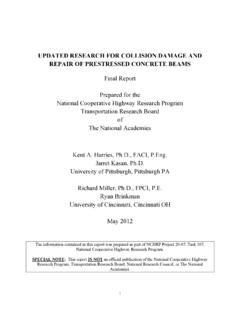Transcription of Guide to Watershed Project Permitting for the …
1 Guide to Watershed Project Permitting for the State of California California Association of Resource Conservation Districts Table of Contents Section 1 Navigating the Permitting Process 1. Section 2 Practical Tips for Getting Your Project Approved 3. Section 3 Local Agencies 4. Section 4 State Agencies 4. Section 5 Federal Agencies 7. Section 6 Regional Agencies 8. Section 7 Resources and Printed References 9. Section 8 Analyze Your Project 11. California Association of Resource Conservation Districts Web: Section 1 NAVIGATING THE Permitting PROCESS. A permit is an authorization, license, or equivalent control document issued by the federal, state or local government or other agency to implement the requirements of a regulation or law. A permit is an agreement between the issuing agency and the applicant whereby the applicant agrees to follow the applicable codes and laws governing a Project or type of land use.
2 By issuing and tracking permits, local, state and federal agencies can set minimum standards for activities that protect California's environment both now and in the future. The permit process was developed to provide for orderly development, ensure compliance with applicable regulations, and minimize future impacts as they help to track, authorize and administer a variety of actions. Usually any activity that could have an adverse impact on a wetland or riparian area (creek or stream), clearing vegetation, disturbing ground, or conducting work near a sensitive area requires permits from numerous agencies. Restoration projects typically include the type of work that would require permits. Local, state, federal, and tribal governments require projects, work activities, and actions to receive authorization from applicable regulatory agencies. The Permitting process can be complicated and hard to understand.
3 This manual was created to assist you in getting started by providing basic information and directing you to sources where you can find more information. The Guide to Watershed Project Permitting is broken down into sections for easy reference and the entire manual is simplified in the matrix under the section titled Analyze Your Project . The manual is not intended to be a comprehensive Guide on the how-to's of Permitting . There are already good sources available for those who need detailed information as well as agencies who can assist you in getting started. It is the responsibility of the permit applicant to ensure that they have applied for all required permits. Consult an assistance agency to be sure you have obtained all the necessary permits for your Project (see local, state, regional and federal agencies). R Acronyms and Definitions ACOE Army Corps of Engineers IRWMP Integrated Regional Water Management Plan BCDC San Francisco Bay Conservation and LAA Likely to adversely affect Development Commission LAFCO Local Agency Formation Commission BMP Best Management Practices JARPA Joint Aquatic Resources Permit Application CALTRANS California Department of Transportation NEPA National Environmental Policy Act 1.
4 Section 1. CDFG California Department of Fish & Game NLAA Not likely to adversely affect CEQA California Environmental Quality Act NMFS National Marine Fisheries Service CESA California Endangered Species Act NOAA National Oceanic and Atmospheric Administration CRMP Coordinated Resource Management and Planning NPDES National Pollutant Discharge Elimination System CVFPB Central Valley Flood Protection Board CWA Clean Water Act NRCS Natural Resources Conservation Service DWR Department of Water Resources NWP Nationwide Permits EIS Environmental Impact Statement RCD Resource Conservation District EPA US Environmental Protection Agency RWQCB Regional Water Quality Control Board ESA Endangered Species Act SAA Streambed Alteration Agreement FOTG Field Office Technical Guide SWRCB State Water Resources Control Board HARASS Harass is defined by the USFWS as an TAKE To hunt, harm, harass, pursue.
5 Shoot, wound, intentional or negligent act or omission which kill, capture, trap, or collect a federally listed creates the likelihood of injury to a listed species species by annoying it to such an extent as T&E Threatened and Endangered to significantly disrupt normal behavioral TMDL Total maximum daily load patterns which include, but are not limited to, breeding, feeding, or sheltering. TRPA Tahoe Regional Planning Agency UCCE University of California Cooperative Extension Harm Harm is defined by the USFWS to include USACOE United States Army Corps of Engineers significant habitat modification or degradation USBR US Bureau of Reclamation that results in death or injury to listed species USDA US Department of Agriculture by impairing behavioral patterns including breeding, feeding, or sheltering. USFS US Forest Service USFWS US Fish and Wildlife Service HCP Habitat Conservation Plan USGS US Geological Survey R Getting Started The most important thing to remember when navigating the Permitting process, is to start early!
6 Contact all the agencies simultaneously as the Permitting process can take time and should be initiated up to a year before the desired Project start date. Many permit applications have fees associated with them. It is a good idea to have a budget and know the costs ahead of time. When you contact the appropriate agency, have your questions ready (see Section 8). If possible, invite all the agencies involved to the Project site at one time to address all their concerns at once, this is to your benefit. National Environmental Policy Act The National Environmental Policy Act (NEPA) was one of the first laws ever written to establish a broad national framework for protecting our environment. NEPA's basic policy is to assure that all branches of government give proper consideration to the environment prior to undertaking any major federal action that significantly affects the environment.
7 It requires all federal agencies to promote efforts to prevent or eliminate damage to the environment and biosphere by following mandated procedures. In order to reach an informed decision, NEPA requires a prescribed process, including public involvement, scientific analysis and potential mitigations. NEPA compliance is mandated when a federal agency provides financial assistance but is not mandated when a federal agency (such as the NRCS) provides only technical assistance. California Environmental Quality Review The local or state government with the most jurisdictional responsibility for your Project must review it under requirements of the California Environmental Quality Act (CEQA). The main purpose of CEQA review is to identify and prevent potentially significant environmental impacts from proposed projects. R Assistance Organizations Resource Conservation Districts Resource Conservation Districts (RCDs) are non-regulatory local entities which give assistance to agricultural and other landowners.
8 RCDs are units of government organized by residents under State law. Districts operate on the premise that local people know more about local problems than anyone else. Bridging agricultural issues with science, education and government, RCDs are an information network assisting with landowner resource issues to provide solutions. Districts are empowered to conduct soil and water resources research, make improvements on public lands, disseminate conservation information, assist private landowners, develop soil and water conservation plans, and establish standards of cropping tillage 2. Section 1. and range practices. RCDs often work in conjunction with NRCS to provide technical assistance on projects and specific resource problems. To find your local RCD, contact California Association of Resource Conservation Districts (CARCD) at (916) 447-7237, online or via email You may also contact National Association of Conservation Districts (NACD) Service Center at (202) 547-NACD.
9 California Coordinated Resource Management and Planning (CRMP) or Watershed groups Before starting your Project , it may be helpful to also contact your local CRMP or Watershed groups. These groups are unique to a local area and may be able to provide partnership efforts or technical and coordination assistance on your Project . For more information on CRMPs, contact the California CRMP Council at (916) 447-7237 or email A listing of Watershed groups can be found at the UC Davis Natural Resource Projects Inventory (NRPI) website: edu/nrpi. UC Cooperative Extension (UCCE). University of California Cooperative Extension (UCCE) offices are local problem-solving centers. Over 400 campus-based specialists and county-based agriculture, natural, and human resource advisors work as teams to bring the University's research-based information to Californians through more than 50 county offices.
10 UCCE is a full partnership of federal, state, county, and private resources linked in applied research and educational outreach and tailors its programs to meet local needs. The Division also operates ten research and extension centers, or field stations, to test agricultural research and support UC's out-reach to local growers and ranchers. Each center is located in a different terrain and climate, from the Oregon border to the desert 700 miles south. Through these centers and offices, UCCE faculty and staff provide technical and program support for agriculture and natural resource management including habitat restoration. To find your county extension office, visit Department of Conservation Division of Land Resource Protection, RCD Assistance Unit (916) 324-0850. The California Department of Conservation's Division of Land Resource Protection supports conservation at the local level by providing assistance to the state's Resource Conservation Districts (RCDs).





